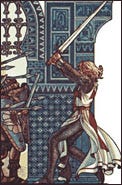Durandal is a forgotten treasure; a classic of the pulp fiction era and a progenitor of the modern heroic fantasy genre. A dark and dramatic epic set in the thirteenth century, it's complex, original, and written in a vivid, cinematic style by a master craftsman. It's no surprise to discover that movie director Cecil B. de Mille recognized Lamb's talents and employed him as technical advisor and screenwriter for several de Mille productions.
Sir Hugh of Taranto is an idealistic young knight, part of a contingent of Frankish Crusaders supporting the Byzantine Emperor Theodore Lascaris against Islamic Turkish forces at Antioch. During the battle the Franks are callously betrayed by their allies. Only one survives slaughter by the Turks: Sir Hugh, saved from certain death by a mysterious warrior who bequeaths him Durandal, the legendary sword once owned by Charlemagne's paladin, Roland.
Vowing vengeance for his comrades and pursued by Imperial agents who want no living witnesses to the Emperor's perfidy, Sir Hugh's twisting and turning path leads him ever further East, through Syria and Persia into the Caucasus, where he is captured by Mongol tribesmen, outriders of Genghis Khan's army.
This is pure high adventure, full of action and intrigue, ringing with battle cries and clashing swords, and clearly in the tradition of nineteenth century authors like H. Rider Haggard, Sir Walter Scott and William Morris. It's no simplistic "Boy's Own" tale, though. There are no cardboard cutout villains inspired by xenophobia. The few women who appear are strong personalities, confident in their female power. Believable characters and settings both exotic yet realistic reflect Harold Lamb's extensive knowledge about the period and the peoples and places featured in Durandal.
In this more cynical age it's refreshing to read a story which unashamedly celebrates the virtues of honor, duty and loyalty, not confined to any one race or religion, and comradeship which transcends all cultural barriers. (1931, 370 pages)



